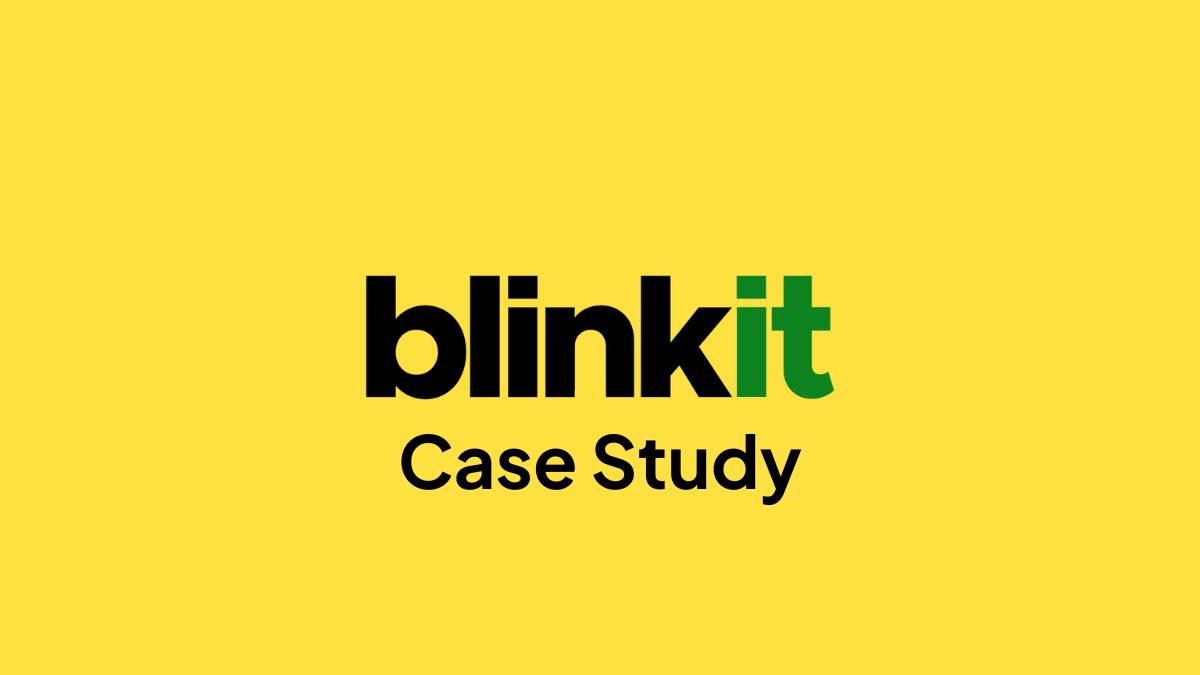Table of Contents
Introduction: Blinkit Case Study Overview
Blinkit, previously known as Grofers, has changed a lot over the years. What started as a regular online grocery service is now India’s go-to ultra-fast delivery platform. The promise is simple: groceries at your doorstep in about 10 minutes. It sounds almost unbelievable, but that’s exactly what Blinkit is built around. Speed is their big deal.
The rise of quick commerce, or q-commerce, in India makes this shift even more interesting. People are busier than ever. Urban lifestyles, longer work hours, and shrinking patience for waiting have made fast delivery a top priority. Blinkit has tapped right into that. They didn’t just improve delivery times, they rethought the whole shopping experience for convenience and speed.
For anyone in marketing or business, this Blinkit case study isn’t just about a grocery app. It’s about how a brand can understand its customers, use data smartly, and be bold with its promises to win big. There’s a lot to learn here about digital marketing, product positioning, and even operations.
Blinkit Market Opportunity: Quick Commerce in India
Online grocery shopping in India has grown fast from 2023 to 2025. But it’s not just about more people buying online, it’s about how quickly they want things. Research shows 62% of urban shoppers put delivery speed at the top of their list. That’s huge. Blinkit noticed this early and built their strategy around it.
The quick commerce market is exploding. From $2.8 billion in 2023, it’s expected to cross $5 billion by 2025. Smartphones, easy payments, and micro-fulfillment centers in cities are all helping make that possible. Basically, the faster you can deliver, the bigger the advantage.
Blinkit didn’t just look at numbers, they looked at behavior. What do people want, when, and how? That shaped everything. From deciding which neighborhoods to cover first to offering personalized suggestions, they leaned heavily on insights. Quick commerce isn’t just delivery, it’s delivering the right experience at the right moment. Blinkit figured that out and ran with it.
Also Read: Ola Case Study
Blinkit Product Marketing Strategy: Key Insights
Blinkit’s marketing is where things really stand out. The whole approach feels built around one idea: speed. But it’s not just about delivering groceries fast. It’s about making the experience smooth, easy, and even a little fun. Every move seems to tie back to that.
1. Pivot to Ultra-Fast Delivery
The 10-minute delivery promise is Blinkit’s big claim. It’s loud, it gets noticed. But it’s not empty words. A lot of work happens behind the scenes. Micro-fulfillment centers are close to dense city areas. Routes are optimized. Tech tracks every delivery in real-time.
It’s not just speed. It’s reliability. That’s why users trust them. They know what to expect. And that’s helped Blinkit become the first name people think of when it comes to ultra-fast grocery delivery. Simple as that.
2. Personalized Marketing & Dynamic Product Recommendations
Blinkit doesn’t treat every user the same. They use location-based targeting and smart recommendations. The app shows what’s popular in your area. It knows your shopping patterns. Time of day matters. Your usual buys matter.
These little nudges are everywhere. Breakfast items in the morning, snacks in the evening. Limited-time offers on stuff you’ve looked at before. It pushes impulse buys without feeling pushy. Makes shopping feel easier. Makes it fast. Makes it habitual.
3. Digital Marketing & User Engagement Tactics
Blinkit’s social media is lively. Micro-memes, trending events, influencer collabs, they use it all. Paid ads bring new users in. Retargeting keeps them coming back.
Retention is thought out. Push notifications, emails, loyalty programs, they all work together. Even city-specific promotions feel personal. Small touches, big difference.
4. Brand Personality & Social Media Positioning
Blinkit isn’t just a service. It’s a personality. Friendly. Relatable. Speedy. Like a helpful friend who shows up exactly when you need them.
Humor is everywhere, memes, witty posts, collabs with Netflix India and Zomato. Interactive content too: recipes, grocery hacks, user-generated posts. Keeps people involved. Feels real. Feels alive. Feels like Blinkit isn’t just delivering groceries, they’re part of daily life.
Also Read: Duolingo Case Study
Blinkit Performance Metrics & Marketing Impact
- Market share: 46% of India’s online grocery delivery market in 2024. Nearly half the sector, big deal. (Source)
- App downloads growth: 60% increase in just three months. People were curious. They tried it. And stayed.
- Repeat customers: Up 45%, thanks to smart personalized recommendations. Right items, right time. Works every time.
- Revenue growth: 75% YoY, INR 3,500 crore GMV in 2024. Speed and scale paying off. (Source)
- Delivery efficiency: Under 10 minutes across 30+ cities. Promise kept, consistently. (Source)
- Social media engagement: Up 85% with memes, influencer campaigns, and interactive content. People notice. People talk. Brand stays alive.
Small moves, big impact. Blinkit makes it look effortless.

Apply Now: Product Marketing Course
Blinkit Competitive Landscape
Key competitors
Zepto, Dunzo, and a bunch of new q-commerce startups are all fighting for attention. Every brand wants a piece of India’s fast grocery market. Blinkit can’t slow down. Innovation and quick moves are the only way to stay ahead.
Innovation trends in the industry
Dark stores are popping up everywhere. Electric delivery bikes, drones, even voice orders are becoming a thing. The market is moving fast. Anyone not keeping up risks falling behind.
How Blinkit differentiates
Blinkit focuses on speed, personalization, and a brand that feels human. Competitors might compete on price or selection. Blinkit competes on being fast, relevant, and actually fun to engage with. That’s what keeps users coming back.
Also Read: Zara Case Study
Challenges Faced by Blinkit in Product Marketing
1. Scaling ultra-fast delivery nationwide
Going beyond big cities isn’t simple. Traffic, infrastructure, demand patterns, it all matters. Keeping 10-minute delivery consistent everywhere is a huge challenge.
2. Logistics and franchise network management
Hundreds of partners, dozens of micro-warehouses, and constant coordination. Blinkit has to stay on top of every little piece or things can go wrong.
3. Maintaining product quality and customer satisfaction
Speed is nothing without quality. Fresh products, correct orders, and happy customers all need attention. One slip, and trust drops fast.
4. Balancing speed with operational efficiency
Fast delivery costs money. Routes, inventory, and staffing all need careful planning. Blinkit has to juggle speed, cost, and reliability all at once.
Also Read: Starbucks Case Study
Future Outlook: Blinkit Product Marketing & Growth
1. Technology-driven improvements
Blinkit is leaning on tech in every corner. AI helps predict demand. Smart inventory systems keep products ready. Data analytics guide deliveries and reduce mistakes. Small operational tweaks add up. The goal is faster, smoother service without raising costs.
2. Expansion opportunities in Tier 2–3 cities
Big cities are mostly covered. Smaller cities are catching up fast. People want the same convenience. Blinkit can use micro-fulfillment centers, local partnerships, and city-specific campaigns. It’s not simple, but the potential is huge. Growth outside metro areas is next big play.
3. Potential marketing innovations
Gamification, AR/VR shopping, and loyalty programs could make shopping fun. Blinkit is exploring ways to keep users engaged while ordering. Experiences that feel interactive, playful, or rewarding will stick. Marketing isn’t just ads, it’s building habits and excitement around the app.
4. Expected continued dominance
Blinkit is set to stay ahead. Speed, personalization, and relatable branding work together. Competitors may try to catch up, but Blinkit’s combination of tech and marketing keeps it top of mind. The brand looks ready to lead India’s quick commerce market for the foreseeable future.
Also Read: Netflix Case Study
Key Takeaways from the Blinkit Case Study
1. Blueprint for ultra-fast delivery brands
Blinkit shows the power of a clear promise. Speed drives operations, marketing, and customer experience. Everything else aligns around it. Other brands can take notes. Clear focus simplifies decisions and builds loyalty.
2. Leveraging personalization, humor, and social media
Personalized recommendations, witty posts, and memes make the brand relatable. Social media is more than marketing, it’s engagement. People notice and share. The mix keeps users coming back, while creating a fun, human brand voice.
3. Transforming online grocery shopping
Blinkit didn’t just deliver faster, it changed expectations. Consumers now want speed, reliability, and convenience together. The market adjusted. Competitors had to rethink. Blinkit set the standard and created a new normal for Indian grocery delivery.
4. Practical insights for marketers
Operational efficiency, smart use of data, and creative engagement all matter. Small details, like timing notifications or suggesting the right items, add up. Consistency beats hype. The case shows how to combine strategy, execution, and personality effectively.
Also Read: Dollar Shave Club Case Study
Conclusion
Blinkit shows what happens when speed, personalization, and engagement come together with solid operations. The brand didn’t just make groceries faster, it changed what people expect from quick commerce in India. Every small move matters: micro-fulfillment centers, smart recommendations, memes, influencer campaigns. It’s about building trust, being reliable, and keeping users engaged. Other brands can take notes. Focus on clarity, personalization, and small touches that make a difference. Speed grabs attention, but the overall experience keeps people coming back. Blinkit proves that a fast, relatable, and thoughtful brand can dominate a competitive market. The lesson is simple: align operations, marketing, and customer experience, and growth follows.
FAQs: Blinkit Case Study
What makes Blinkit different from other grocery delivery apps?
Blinkit isn’t just another grocery app. The speed sets it apart, 10-minute deliveries make it stand out. Then there’s personalization. Recommendations match local trends, time of day, and shopping habits. Add a bit of humor and relatable social media content, and users feel like the brand gets them.
How does Blinkit achieve ultra-fast delivery?
It’s a mix of smart logistics and tech. Micro-fulfillment centers keep items close to customers. Routes are optimized, deliveries tracked in real time. Teams coordinate tightly. Stock is pre-positioned. The result? Fast deliveries that feel almost effortless. Speed is consistent, city after city.
What digital marketing strategies does Blinkit use?
Social media is a big focus. Micro-memes, influencer collabs, and trending posts grab attention. Paid ads bring in new users. Push notifications, emails, and loyalty programs keep them coming back. The marketing feels human, fun, and relevant, never just promotional.
How has Blinkit grown its market share in India?
Fast delivery grabbed attention first. Then consistent service and personalized suggestions built trust. Targeted city launches, local promotions, and influencer campaigns spread awareness. People tried it, liked it, and kept using it. That combination helped Blinkit secure nearly half of India’s online grocery market.
Can Blinkit’s product marketing strategy be applied to other sectors?
Absolutely. The principles work anywhere: clear value, personalization, engaging content, and reliable service. Brands that want loyalty and repeat customers can use these tactics. The key is knowing your customer, acting on insights, and delivering consistently. Simple, but it works.

